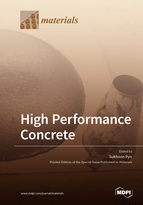High Performance Concrete
A special issue of Materials (ISSN 1996-1944). This special issue belongs to the section "Construction and Building Materials".
Deadline for manuscript submissions: closed (31 May 2021) | Viewed by 71599
Special Issue Editor
Interests: ultra high performance concrete; sound-absorbable high performance concrete; railway; composites; sustainable construction materials
Special Issues, Collections and Topics in MDPI journals
Special Issue Information
Dear Colleagues,
Concrete has traditionally been the subject of many researchers’ attention, being a widely used material in the construction sector. As the technology of concrete improves, various kinds of high performance concrete have recently been developed and used. This Special Issue focuses on the various types of “High Performance Concrete” and their applications, which will be published in Materials, an interdisciplinary journal dedicated to covering leading research and developments in the field of materials science and engineering. This Special Issue encompasses the field of advanced concrete- and/or cement-based composites and their structural applications. Potential topics include, but are not limited to, the following: high performance concrete; ultra high performance concrete; sound-absorbable high performance concrete; sustainable construction materials; self-compacting concrete; engineered cementitious composites; highly durable concrete; ultra-lightweight concrete; high strength–high ductility concrete; and structural applications.
Please consider this invitation to submit a manuscript for this Special Issue. Full papers, communications, and reviews are all welcome.
Prof. Dr. Sukhoon Pyo
Guest Editor
Manuscript Submission Information
Manuscripts should be submitted online at www.mdpi.com by registering and logging in to this website. Once you are registered, click here to go to the submission form. Manuscripts can be submitted until the deadline. All submissions that pass pre-check are peer-reviewed. Accepted papers will be published continuously in the journal (as soon as accepted) and will be listed together on the special issue website. Research articles, review articles as well as short communications are invited. For planned papers, a title and short abstract (about 100 words) can be sent to the Editorial Office for announcement on this website.
Submitted manuscripts should not have been published previously, nor be under consideration for publication elsewhere (except conference proceedings papers). All manuscripts are thoroughly refereed through a single-blind peer-review process. A guide for authors and other relevant information for submission of manuscripts is available on the Instructions for Authors page. Materials is an international peer-reviewed open access semimonthly journal published by MDPI.
Please visit the Instructions for Authors page before submitting a manuscript. The Article Processing Charge (APC) for publication in this open access journal is 2600 CHF (Swiss Francs). Submitted papers should be well formatted and use good English. Authors may use MDPI's English editing service prior to publication or during author revisions.
Keywords
- high performance concrete
- ultra high performance concrete
- sound-absorbable high performance concrete
- sustainable construction materials
- self-compacting concrete
- engineered cementitious composites
- highly durable concrete
- ultra-lightweight concrete
- high strength–high ductility concrete
- structural applications of high performance concrete







